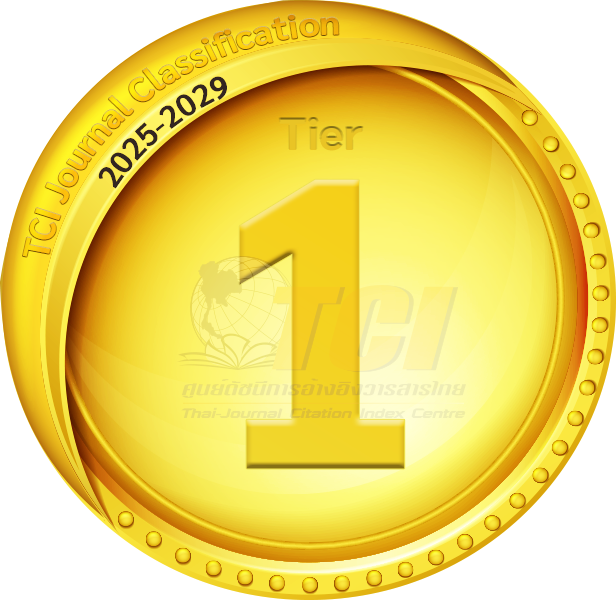CUTOFF VALUE OF TWO-POINT DISCRIMINATION DISTANCES IN CARPAL TUNNEL SYNDROME
DOI:
https://doi.org/10.55374/jseamed.v4i1.53Keywords:
Sensory testing, Two-point discrimination test, Carpal tunnel syndromeAbstract
Background: Two-point discrimination test (2PD) represents large sensor fiber, which is more sensitive than smaller fiber to detect abnormality in carpal tunnel syndrome (CTS). Few studies have focused in 2PD to diagnose CTS.
Objective: The study aimed to establish the cutoff value of 2PD to determine CTS.
Methods: A descriptive diagnostic study was conducted at the Outpatient Department of Rehabilitation Medicine, Phramongkutklao Hospital. Participants who were suspected of having CTS were included in the study. All participants performed the 2PD test at the thumb, index finger and middle finger. The nerve conduction studies were performed and definitive diagnosis of CTS was based on the results. Data were analyzed using the receiver operation coefficient curve.
Results: Of 48 participants (total of 95 hands), CTS was diagnosed in 85 hands (89.5%). Additionally, of all CTS hands, severity was mild degree in 17 hands (28.4%), moderate degree in 31 hands (32.6%) and severe degree in 37 hands (39%). The optimum cutoff values were >4 mm having the sensitivities of 75.3, 68.2 and 68.2% while the specificities were 80, 90 and 90%, respectively, for the thumb, index finger and middle finger. The areas under curve were 0.826, 0.833 and 0.823, respectively.
Conclusion: The participants with more than 4 mm of 2PD at the thumb, index finger and middle finger had high probability of having CTS.
Downloads
Metrics
References
Robinson LR. Electrodiagnosis of carpal tunnel syndrome. Phys Med Rehabil Clin N Am 2007; 18: 733-46, vi. DOI: https://doi.org/10.1016/j.pmr.2007.07.008
Palmer KT, Harris EC, Coggon D. Carpal tunnel syndrome and its relation to occupation: a systematic literature review. Occup Med (Lond) 2007; 57: 57-66. DOI: https://doi.org/10.1093/occmed/kql125
Preston DC SB. Electromyography and neuromuscular disorders, clinical electro physiologic correlation, 2nd ed. Pensylvania: Elsevier; 2005.
Herrmann DN, Logigian EL. Electrodiagnostic approach to the patient with suspected mononeuropathy of the upper extremity. Neurol Clin 2002; 20: 451-78, vii. DOI: https://doi.org/10.1016/S0733-8619(01)00008-1
Nadler SF SS, Nadler JS. Cumulative trauma disorders. In: DeLisa JA GB, Walsh NE, editor. Physical medicine and rehabilitation: principles and practice. 4th ed. Philadelphia: Lippincott Williams & Wilkins; 2005. p. 615–30.
Aroori S, Spence RAJ. Carpal tunnel syndrome. Ulster Med J 2008;77: 6-17.
Jablecki CK, Andary MT, So YT, Wilkins DE, Williams FH. Literature review of the usefulness of nerve conduction studies and electromyography for the evaluation of patients with carpal tunnel syndrome. AAEM Quality Assurance Committee. Muscle Nerve 1993; 16: 1392-414. DOI: https://doi.org/10.1002/mus.880161220
Kohara N. Clinical and electrophysiological findings in carpal tunnel syndrome. Brain Nerve 2007; 59: 1229-38.
Shooter D. Use of two-point discrimination as a nerve repair assessment tool: preliminary report. ANZ J Surg 2005; 75: 866-8. DOI: https://doi.org/10.1111/j.1445-2197.2005.03557.x
Tamburin S, Cacciatori C, Praitano ML, Cazzarolli C, Foscato C, Fiaschi A, et al. Median nerve small- and large-fiber damage in carpal tunnel syndrome: a quantitative sensory testing study. J Pain 2011; 12: 205-12. DOI: https://doi.org/10.1016/j.jpain.2010.06.010
Pipatyaokul R, Jianmongkol S, Kowsuwon W. Reliability of the compasses for measuring two-point discrimination and moving two-point discrimination test compared with the Disk-criminator. Srinagarind Med J 2006; 21: 57-66.
Marx RG, Hudak PL, Bombardier C, Graham B, Goldsmith C, Wright JG. The reliability of physical examination for carpal tunnel syndrome. J Hand Surg Br 1998; 23: 499- 502. DOI: https://doi.org/10.1016/S0266-7681(98)80132-0
Magee DJ. Orthopedic Physical Assessment. London, United Kingdom: Elsevier Health Sciences; 5th ed. 2008.
Marlowe ES, Bonner FJ, Jr., Berkowitz AR. Correlation between two-point discrimination and median nerve sensory response. Muscle Nerve 1999; 22: 1196-200. DOI: https://doi.org/10.1002/(SICI)1097-4598(199909)22:9<1196::AID-MUS5>3.0.CO;2-K
Braddom RL. Physical Medicine & Rehabilitation. Philadelphia: Elsevier Saunders; 4th ed. 2011.
MacDermid JC, Doherty T. Clinical and electrodiagnostic testing of carpal tunnel syndrome: a narrative review. J Orthop Sports Phys Ther 2004; 34: 565-88. DOI: https://doi.org/10.2519/jospt.2004.34.10.565
MacDermid JC, Wessel J. Clinical diagnosis of carpal tunnel syndrome: a systematic review. J Hand Ther 2004; 17: 309-19.
Elfar JC, Yaseen Z, Stern PJ, Kiefhaber TR. Individual finger sensibility in carpal tunnel syndrome. J Hand Surg Am 2010; 35: 1807-12. DOI: https://doi.org/10.1016/j.jhsa.2010.08.013
Kuhlman KA, Hennessey WJ. Sensitivity and specificity of carpal tunnel syndrome signs. Am J Phys Med Rehabil 1997; 76: 451-7. DOI: https://doi.org/10.1097/00002060-199711000-00004
Ziswiler HR, Reichenbach S, Vogelin E, Bachmann LM, Villiger PM, Juni P. Diagnostic value of sonography in patients with suspected carpal tunnel syndrome: a prospective study. Arthritis Rheum 2005; 52: 304-11. DOI: https://doi.org/10.1002/art.20723
Crosby PM, Dellon AL. Comparison of two-point discrimination testing devices. Microsurgery 1989; 10: 134-7. DOI: https://doi.org/10.1002/micr.1920100214
Basiri K, Katirji B. Practical approach to electrodiagnosis of the carpal tunnel syndrome: A review. Adv Biomed Res 2015; 4: 50. DOI: https://doi.org/10.4103/2277-9175.151552
Jablecki CK, Andary MT, Floeter MK, Miller RG, Quartly CA, Vennix MJ, et al. Practice parameter: Electrodiagnostic studies in carpal tunnel syndrome. Report of the American Association of Electrodiagnostic Medicine, American Academy of Neurology, and the American Academy of Physical Medicine and Rehabilitation. Neurology 2002; 58: 1589-92. DOI: https://doi.org/10.1212/WNL.58.11.1589
Werner RA, Andary M. Electrodiagnostic evaluation of carpal tunnel syndrome. Muscle Nerve 2011; 44: 597-607. DOI: https://doi.org/10.1002/mus.22208
Borg K, Lindblom U. Diagnostic value of quantitative sensory testing (QST) in carpal tunnel syndrome. Acta Neurol Scand 1988; 78: 537-41. DOI: https://doi.org/10.1111/j.1600-0404.1988.tb03698.x
Vorawanthanachai T, Wongtra-gnan N, Kovindha A. Correlation between static two-point discrimination test and nerve conduction study of ulnar nerve in patients with ulnar neuropathy at the elbow. J Thai Rehabil Med 2012; 22: 95-101.
Wolny T, Saulicz E, Linek P, Myśliwiec A. Two-point discrimination and kinesthetic sense disorders in productive age individuals with carpal tunnel syndrome. J Occup Health 2016; 58: 289-96. DOI: https://doi.org/10.1539/joh.15-0108-OA
Khanittanuphong P, Leelasamran W, Boonmeeprakob A. Diagnostic accuracy of provocative tests in the diagnosis of carpal tunnel syndrome. J Thai Rehabil Med 2011; 21: 56-62.
MacDermid JC, Wessel J. Clinical diagnosis of carpal tunnel syndrome: a systematic review. J Hand Ther 2004; 17: 309-19. DOI: https://doi.org/10.1197/j.jht.2004.02.015

Downloads
Published
How to Cite
Issue
Section
License
The Journal of Southeast Asian Medical Research will hold the copyright to all published articles. The publisher's production department handles copyright forms once a manuscript is accepted and scheduled for publication.







